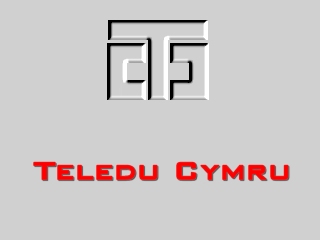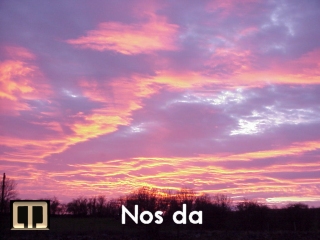| The
new company's ident formed up on a gold and black background,
with a silver bar emerging from the bottom... |

|

|
...turning
into a 'T'... |
| ...with
two 'C's (one inverted) sliding in from either side... |

|

|
...and
being completed by the company's name. There were variations
on this pattern - one where the background was light at
the top and dark at the bottom, and another (rarely shown)
where the background gradient was blue rather than gold).
A fanfare of ascending chords marked the whole show, the
first time sound was used with an ident. |
| They
also had this rather neat clock based on the company's logo. |

|

|
The
programmes hadn't changed very much, though. This was scarcely
surprising given that money was tight, and that most of
ATC's staff had been transferred over to the new licensee.
The news and parliamentary report were now followed by all
of 45 minutes of local programming (which could vary from
current affairs to culture to old men who put ferrets down
their trousers) ; then there was that soap, inching towards
its twentieth year, a guessing game with a panel of celebrities,
then the news headlines. On this particular Thursday, the
bulletin was followed by an espionage thriller, then a new
current affairs round-up "From Day To Day" at
10:15. The evening closed with a showcase of music from
the annual Bala Fair and the closing headlines. |
| As
successful as the new image was, it didn't stop the company
junking most of it just three years later. Silver was in,
darlings, even in Machynlleth, and so was drop-shadowed
lettering. |

|

|
Shock, horror! There was now television on Sunday! The objections
of the old puritans had finally been faced down. Not that
the line-up was particularly attractive to most. This run-down
shows it all too vividly ; the early evening news was followed
by a cultural round-up of the week, Handel's "Messiah"
performed by the Royal Court Choir, a religious discussion
programme and the news headlines and weather, before the
sinful few viewers were ushered off to bed at 10.15. |
| There
were some useful innovations in programming, though, such
as "Long Life", which gave a forum to that portion
of the population over 60 to voice their experiences and
concerns (usually a lot of complaining about how rude, inconsiderate
and disrespectful the younger generation had become). |

|

|
The
silver look never really caught on with the viewers, and
by 1989 it was all change once more. The logo remained,
but now it was back to the Gold Standard on a black background. |
| Not
that the programming showed much sign of changing. Oh, looky
here! Guess what's on at 7:30! Twenty-four years on and
still going, sandwiched on this occasion between a magazine
programme and a murder mystery series. Viewers were allowed
some amusement, though, with a comedy programme at 9:35
and a broadcast of highlights from a major music festival
in Ireland, with the day's current affairs analysis squatting
incongruously in between them. |

|

|
CTC
was, of course, non-commercial, which left the vexing problem
of how to fill gaps between programmes. One way was to show
the station's logo, but transformed into various shapes
and patterns by all this modern technology. Unfortunately
technology runs like clockwork, that is to say that it goes
"Cuckoo!" from time to time, and on one infamous occasion the
folding, twisting and zooming of the logo stopped suddenly
on this rather worrying transformation, and couldn't be
restarted for some minutes. Press journalists, ever eager
to twist the knife in the back of TV when they weren't appearing
on it themselves, gleefully reported that small children
had run screaming from living rooms from Flint to Ferryside.
The head of the channel was summoned to an urgent meeting
with the Minister... |
| CTC
decided that they desperately needed to boost their public-service
credentials to make up for lost goodwill. It got its chance
in the October of 1990, when severe flooding disrupted much
of the western half of the country. This caption shows red
alerts for four rivers. |

|

|
Sport was a surprisingly recent addition to the schedules.
The governing bodies had been very wary of allowing substantial
coverage for fear that attendances at events would suffer.
There was some relaxation of this attitude by now, however,
and this caption trails highlights of the 1991 grand final
of the national tournament of Bando (a game a bit like shinty
or hurling) between the reigning champions from the central
district of Arwystli and the upstart challengers from Erging
in the south-east. |
| And
if you missed the score, you could catch up from the late-night
news headlines. These had always been voiced out-of-vision
over captions like this one. |

|

|
The
1989 style proved remarkably popular and durable, and it
wasn't until 1994, when a new programme director took over
and decided (as they always seem to do) that he wanted to
make his own mark, that it was retired. The change was quite
radical, too. Out went the old logo after 11 years, to be
replaced by this dragon. Both the dragon and then the name
would fade into the picture. |
| Need
I say that some things never change? Well, I needn't, not
when you see this Wednesday-night menu. The early evening
showed no change from 1989, and although some new comedy
and quiz games intervened, followed by a sports round-up,
there was still a current affairs programme ("The Front
Page") sometime after 10. "Beyond The Door"
at 11:15 was quite daring, however, being a behind the
scenes look at the life of an ordinary family in a suburb
of Machynlleth. Warts and all, much to the invented moral
outrage of politicians and the press, and the titillated
joy of the viewers. |

|

|
The
new idents weren't really working, though, and a decision
to remodel them was taken. Early 1995, then, saw a change
of colour scheme. This was effective enough to take Teledu
Cymru through to the autumn of 1997... |
| ...When
black was back. And gold, too. And another new logo. Yes,
it looked like an 'M', but it was really just a reformulation
of the old CTC logo of days gone by. |

|

|
It
was seldom seen on its own, though. Usually, it was to be
found sitting in the corner of various views of the country,
like this one. "Autumn on Teledu Cymru", it says,
as if people couldn't guess what time of year it was. |
| Usually,
however, they referred more to the time of day (although
the cannier portion of the populace probably knew what that
was without being told, as well). This is a "Good Afternoon"
slide, shown in the run-up to the start of programmes. |

|

|
This
little beauty ("Good Night") was a favourite with
many, being shown at closedown. |
| Everything
was thrown into turmoil in April 1999 when the King ("Peace
Be On His Soul") died. This caption was the only thing
broadcast during the day of the announcement, and programming
was minimal for some days afterwards. Some were critical
of the fact that the company had stuck its logo (however
discreetly) on the screen at such a time, but most people's
minds were elsewhere, and Teledu Cymru escaped. |

|

|
So
it was still there to mark the turning of the age at the
end of 1999. This still from coverage of the national millennium
party reads "Welcome to the 3rd millennium!" Note
the digital clock in the top left showing that the Hour
had only just arrived. |
| A
new age, a new start. Well, all right, it took them about
eighteen months to get around to it, and many wondered if
it had been worth the wait when they saw the new ident.
The Celtic Cross was a nice idea, but red lettering on green?
Ych-a-fi! |

|

|
The
programme menus were, thankfully, a little more muted, preferring
blue text. For the very first time, the main news had been
moved to 6.30, making way for a comedy drama ("Don't
Kick A Wasps' Nest") aimed at teenagers. That bloody
programme is still running, you notice (36 years and counting).
Then a quiz game, the headlines and a programme of rather
tame satirical comedy. A documentary strand leads us up
to the current affairs flagship, but then a controversial
film drama based on the mediaeval tales of the Mabinogi
closed the evening. This was the most daring thing ever
broadcast on television in Wales, as it contained some rather
raw language and a few glimpses of naked flesh. Somehow,
everyone survived the shock. |


























